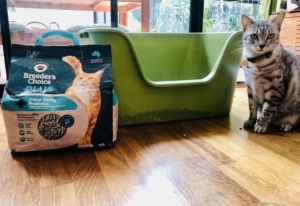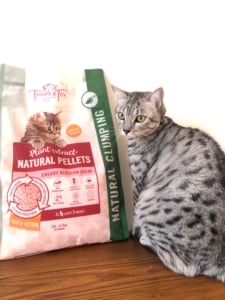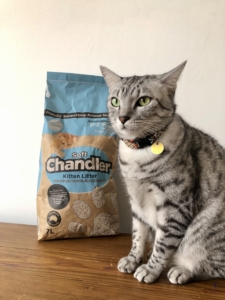February 28, 2025

Choosing the Best Kitty Litter
Choosing the Best Kitty Litter: Ensuring Happy Cats and a Clean Home
Choosing the perfect kitty litter can feel like a bit of a mission, right? It’s not just about keeping your home clean—it’s about making sure your cat’s happy too. With so many options out there, it can be tricky to figure out what works best for both of you. Sometimes you end up buying a litter only to find your cat’s not a fan, leaving you with a bag of unused litter and a disappointed feline.
If you’re living in an apartment, you might be drawn to crystal litter, which is great for absorbing moisture and keeping odours in check—perfect for smaller spaces where smells can linger. But if you’re more eco-conscious, tofu litter could be your best friend. It’s made from natural soybeans, so it’s 100% biodegradable and can be put in your green bin, composted, or flushed down the toilet in small quantities. Let’s not forget wood pellet litter or recycled paper litter, offering a more natural approach to waste management while being gentle on your cat’s paws.
Of course, if your budget’s a little tighter, there’s always clay litter—it’s the classic, reliable choice that’s affordable and does the job, even though it might not be the most eco-friendly option. The key is finding what works for both your cat and your home, while keeping things clean and stress-free!
Let’s explore the key factors to consider and some top choices to keep your kitty purring and your home smelling fresh.
#1 Recycled Paper

After using crystals for several years with our cats without any issues, we were surprised to discover that our new rescue cat had a strong aversion to them. He disliked the crystals so much that he started using the plant pots instead. It seemed that the uncomfortable sensation under his paws was enough to send him fleeing to the plant beds for relief. Looking for a softer alternative for this sensitive kitty’s feet we began using Breeders Choice. This sustainable choice, crafted primarily from recycled paper was a hit with everyone, and we were happy to discover their new range of Breeder’s Choice Plus that contains an odour eating probiotic!
#2 Wood Pellets

We also trialled using the Kitter Wood Pellet Cat Litter, which is reported to be highly absorbent and made from natural wood. Reviews suggested this was the best wood pellet cat litter on the market, since it absorbs liquid waste very quickly and helps with odour control. The upsides are that both cats were happy to use it and it’s fairly affordable, the only downside was that it didn’t last as long as some of the other litters we sampled.
#3 Tofu Litter

For the next trial we opted for Michu Natural Clumping litter. We went for the green tea option as it’s no secret of my love of Japan. I was keen to see if this all-natural, plant-based cat litter that is said to not only controls odours effectively but is also flushable, lived up to the hype and it didn’t disappoint in presentation. The only negative was that when wet it tends to get stuck to the bottom of the litter tray making it a bit tricky to clean.
#4 Natural Clumping Litter with Baking soda

We sampled Trouble and Trix’s Natural Cat Litter, which is blended with a cherry blossom fragrance and made from plant-extracts soya bean and guar gum (tofu, bean plant extract). This makes the litter 100% natural, biodegradable, digestible to kittens and non-toxic. A 10L bag is said to last 5 weeks, so it is good value for money. The only downside is that you have to order online or from a specialist pet store, as it’s not available in the supermarket.
#5 Attapulgite Clay

This range is 100% Australian owned and made. Chandler Cat Litter is renowned for their effective odour-control and long-lasting performance. We opted for the Chandler Soft Kitten Blend as the pieces are smaller and better for our cat’s sensitive paws. It’s made from Attapulgite Clay (also known as Fullers Earth), which is known for its unique structure that consists of tiny air pockets that absorb and locks in liquid and odour compounds, such as ammonia.
Factors to Consider
- Type of Litter:
- Clumping vs. Non-Clumping: Clumping litter forms solid clumps when wet, making it easier to scoop out waste and maintain cleanliness. Non-clumping litter tends to be more economical but requires more frequent complete changes.
- Silica Gel: Known for excellent odour control and absorbing moisture, silica gel litter can be pricier but lasts longer between changes.
- Natural/Organic: Made from materials like corn, wheat, or wood, these litters are environmentally friendly and often biodegradable, though they may vary in clumping ability and odour control.
- Odour Control:
- Look for litters specifically designed to neutralise odours, especially if you live in a small space or have multiple cats.
- Dust Level:
- Some litters produce more dust than others, which can be an issue for both cats and owners with respiratory sensitivities.
- Tracking:
- Consider litters formulated to minimize tracking outside the litter box, which can help keep your floors cleaner.
- Cost and Value:
- Balance the cost per use with the litter’s effectiveness and your budget.
Tips for Success
- Gradual Transition: When switching litters, introduce the new one gradually to avoid upsetting your cat.
- Scoop Regularly: Scoop waste daily and replace litter as needed to maintain freshness.
- Deep Clean Weekly: Empty the litter box completely, clean with mild soap and water, and refill with fresh litter.
- Consider Multiple Boxes: Provide one litter box per cat plus an extra, especially in multi-cat households, to prevent territorial issues and ensure availability.
Choosing the best kitty litter involves understanding your cat’s preferences, your household’s needs, and your own priorities. Whether you prioritise odour control, eco-friendliness, or budget, there’s a litter out there to suit your requirements. By investing time in finding the right one, you’ll ensure a happy cat and a clean, pleasant-smelling home for both you and your beloved feline companion.
Disclaimer: We were not paid by any of the companies above for testing the various types of cat litter. Always remember to seek vet advice before trying new products to ensure they are safe and suitable for your pet.
 Author Bio: Carla Francis is an Australian author, pet travel expert, and feline psychology writer. She is the author of The Zen of Cat, The Cat with Three Passports, and Travelling with Pets (7th edition). Her work has been published in multiple languages and featured in various international media outlets.
Author Bio: Carla Francis is an Australian author, pet travel expert, and feline psychology writer. She is the author of The Zen of Cat, The Cat with Three Passports, and Travelling with Pets (7th edition). Her work has been published in multiple languages and featured in various international media outlets.